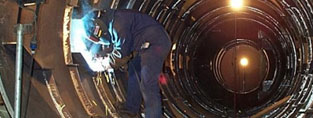
- (03) 5909 8218
- enquiry@fusionweld.com.au
Benefits of Onsite Construction and Maintenance Checks for Pressure Equipment
October 11, 2017

It's important that the following fact is understood. Pressure equipment serviceability is influenced by dynamic forces, by stored energies and dynamic state changing events. Granted, other engineering structures are subjected to damaging forces, but so are pressure vessels. Indeed, pressure equipment is designed to withstand these external energies, plus the internal energies that test their weld seams and flexing metal panels. Consequently, onsite checks exist to monitor dynamic events.
The Benefits of Onsite Maintenance Checks
Even if a pressure vessel absolutely complies with its design specifications and every conceivable inspection code, those recorded and logged test results are based on artificial data. In other words, the manufactured pressure equipment is still on the factory floor. It is strain tested according to some regulatory codes so that the working parts are gauged as ready for installation, but this is still an artificially controlled environment. Onsite conditions, well, they're harder to control. There's an unpredictability factor in play. Onsite maintenance checks are designed to catch these events while they're taking place. Installation and operational errors can't escape this systematic inspection program, nor can environmental episodes elude the checks. A lightning strike, for example, is recorded and the damage addressed when the checks are properly carried out.
First-Party VS. Third-Party Inspections
Onsite structural inspections evaluate common engineering assets. Ladders and support stanchions are assessed as mechanically viable constructs. Meanwhile, a third-party check that targets proprietary pressure equipment is a plausible action, but there are countless system-specific parts here. They're manufactured according to some rather specialized design parameters. Unless that third-party engineering agency has the necessary credentials, perhaps a certification of some sort, then the onsite construction and maintenance checks on the pressure equipment should only ever carried out by the original design team. Viewed as a service beneficial feature, that expertise asserts a specialized skill set, a degree of competence-based proficiency that attends to every proprietary system and component.
In simple terms, that latter benefit translates to specific pressure equipment training. Transported to the onsite equipment, the design team can inspect and test the core components, plus the valves and joints that couple the gear to the system framework. Certified third-party work teams attend to this duty if a training program has been established. Otherwise, the onsite construction and maintenance checks for pressure equipment exist to address that unpredictability factor mentioned earlier. The field inspections detect and address dynamic changes, as set in motion by active pressure systems, then the solution is executed in a timely manner before the site fault develops into a dangerous hazard.
Contact Details
Fusion - Weld Engineering Pty Ltd
ABN 98 068 987619
1865 Frankston Flinders Road,
Hastings, VIC 3915
Ph: (03) 5909 8218
Optimized by NetwizardSEO.com.au
Recent Posts
- Compressed Hydrogen Storage Vessels: Material Selection, Design & Australian Standards
- Welding QA/QC in Oil & Gas Pressure Vessel Fabrication – Ensuring Code Compliance
- AS1210 vs ASME VIII Pressure Vessel Code: Key Differences for Australian Projects
- Mitigating Hydrogen-Induced Cracking in Pressure Vessels: Engineering and Material Strategies
- Storage Tank Solutions Australia: Field-Erected, Prefabricated & Self-Bunded Explained
- Reducing Environmental Risks: Self-Bunded Tanks in Australian Oil & Gas Operations
- Precision in Production: How Pressure Vessels Are Manufactured for Industrial Safety
- Shell & Tube Heat Exchangers: Improve Thermal Control & Energy Recovery in Petrochemical & Pharmaceutical Plants
- In-Service Inspection for Compressed Air Receivers for Power Plant Shutdown Prevention
- Power Plant Pipe Spooling Fabrication – Get Rapid, Code-Compliant Spools Ready for Installation
- Field Erected Tanks: Safe, Reliable On-Site Fuel Storage Solutions in Australia
- Custom Pressure Vessel Fabrication for Flammable Gases
Posts 2025
- Compressed Hydrogen Storage Vessels: Material Selection, Design & Australian Standards
- Welding QA/QC in Oil & Gas Pressure Vessel Fabrication – Ensuring Code Compliance
- View all articles…
Posts 2024
- Large Process Vessels: Optimising the Design for Maximum Efficiency [2025]
- Pressure Equipment Management System Installation: Detect Equipment Faults Early
- View all articles…
Posts 2023
- Pressure Piping System Inspection: A Gift of Safety for the Holidays
- Deaerator Inspections by Fusion-Weld Engineering and How They Reduce System Downtime
- View all articles…
Posts 2022
- How Fusion Weld Keeps Up With AS-NZS ISO 9001:2008 Standard
- Boiler Equipment Safety Inspection During the Summer Season
- View all articles…
Posts 2021
- Avoid These Factors and Practices that Contribute to Sealing Damage in Pressure Vessels
- Do's And Don'ts Of Industrial Boiler Inspection And Maintenance From Fusion-Weld
- View all articles…
Posts 2020
- What are the Risks and Hazards Involved in Pressure Vessel Equipment?
- How to Know if Your Pressure Equipment Needs Repair or Replacement?
- View all articles…
Posts 2019
- Factors that Contribute to Pressure Vessel Failure
- Pressure Vessel Regulations in Australia: What are the Mandatory Requirements?
- View all articles…
Posts 2018
- Pros and Cons of Spherical vs. Cylindrical Pressure Vessels
- What are the Different Hazard Levels in Pressure Vessels?
- View all articles…
Posts 2017
- Transportable Pressure Vessels: The Importance of Inspection and Safety Checks
- Fracture Mechanics and Stress Analysis of Cracks in Pressure Vessels
- View all articles…
Posts 2016
Posts 2015
- What Are Deaerators & Feedwater Vessels?
- Precautions and Safety for Compressed Air Receiver Vessels
- View all articles…
Posts 2014
- Demonstrating In-process Inspection Procedures
- Static Grounding Practices and Standards
- View all articles…